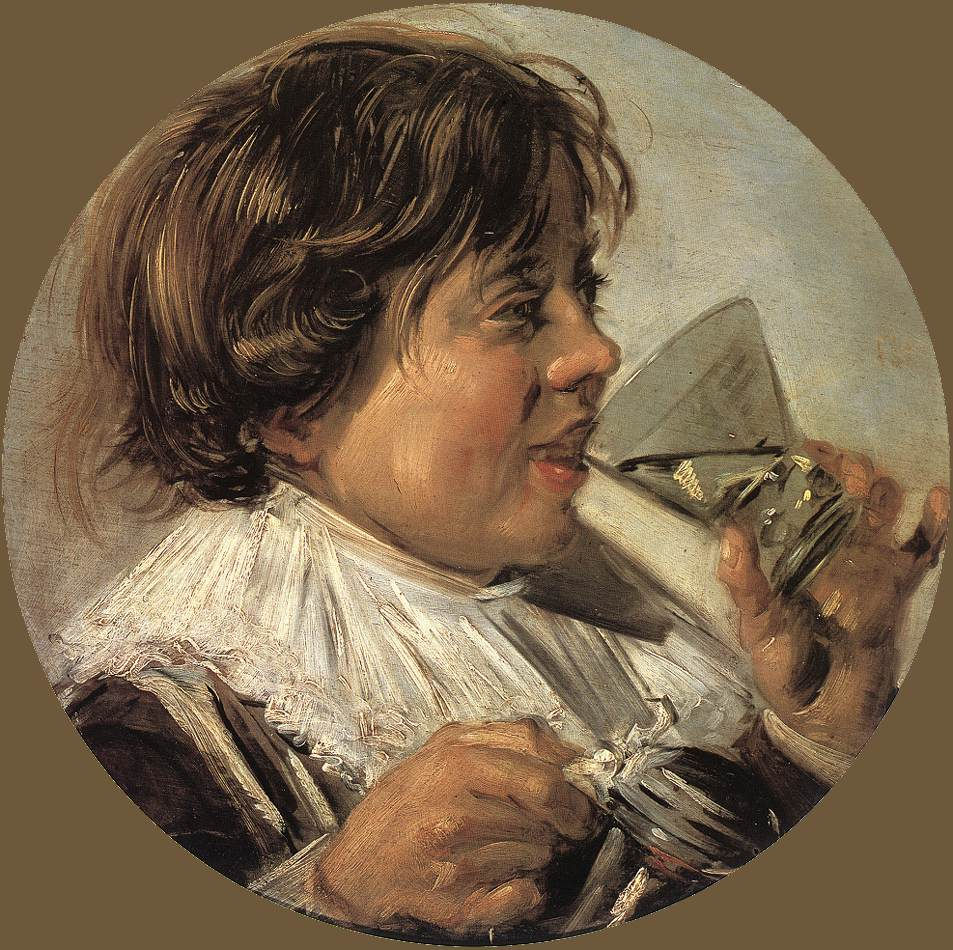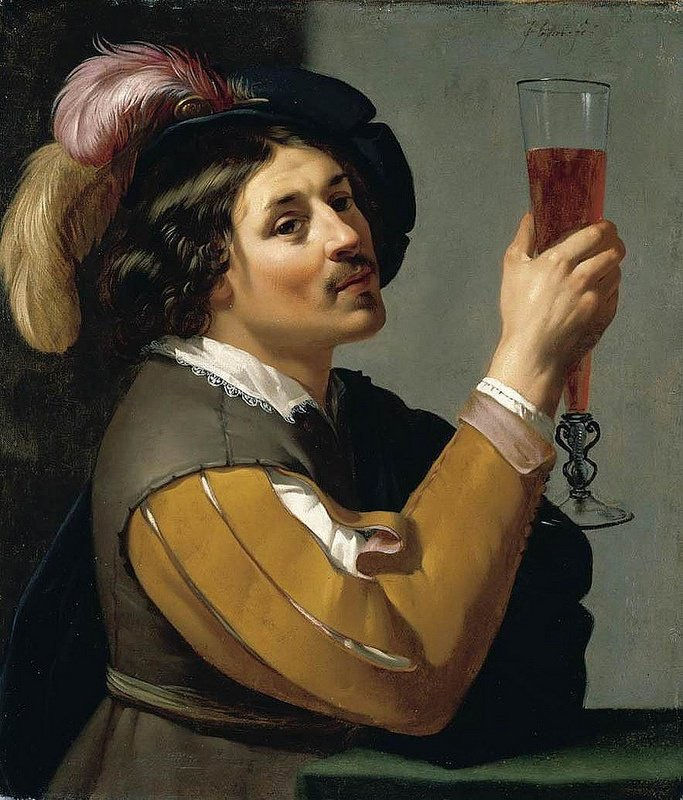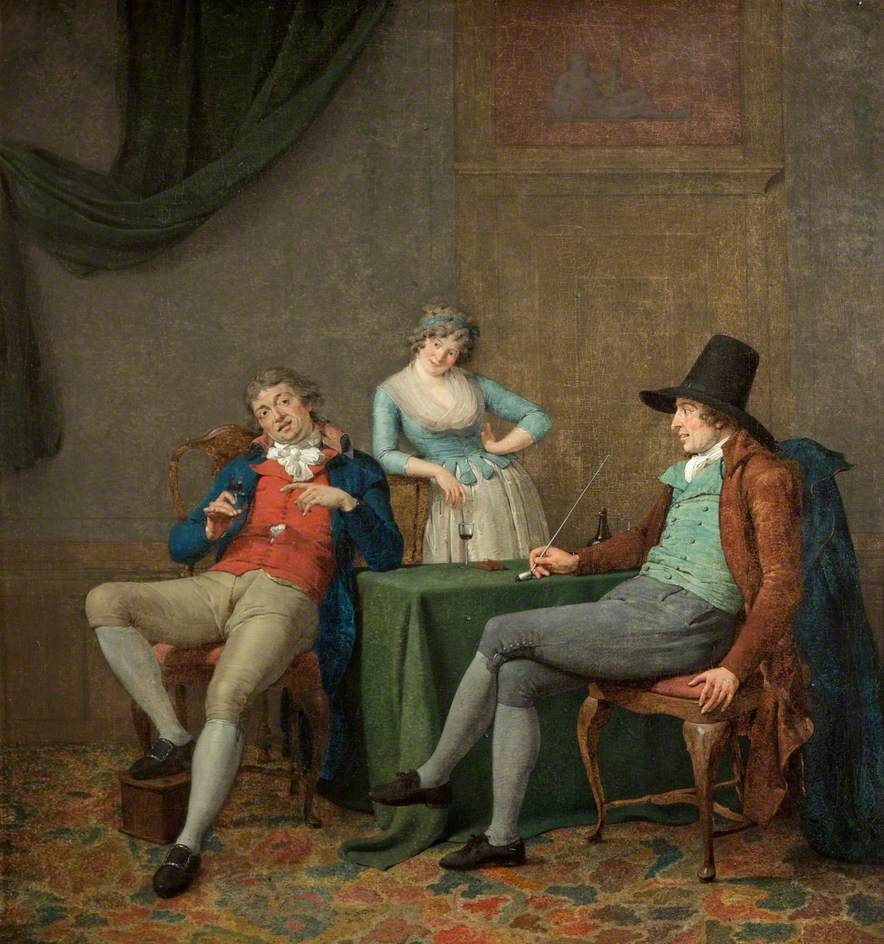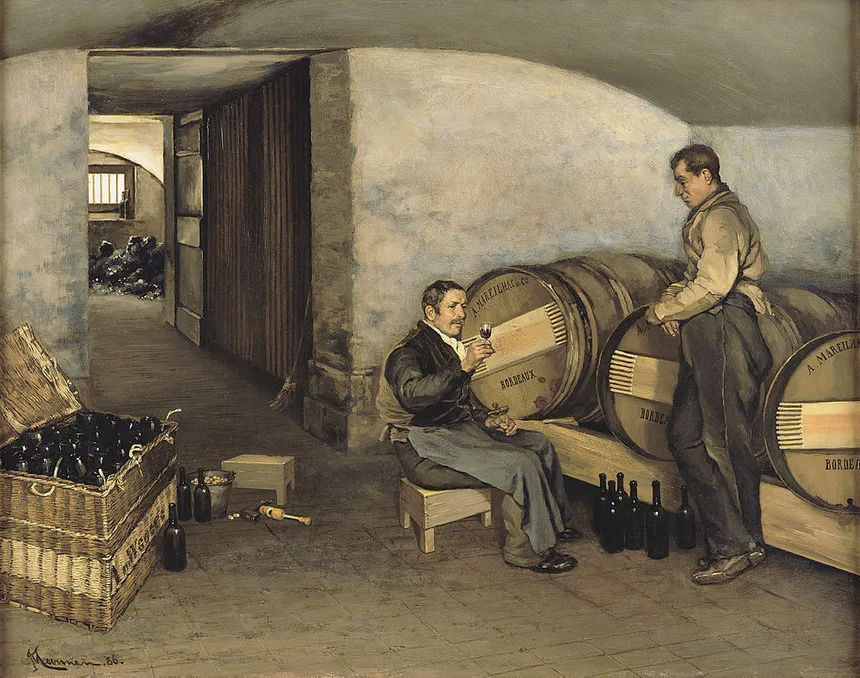Wine and Connoisseurs: Savoir-boire and savoir-parler go together


THE WINE DRINKERS
(LES BUVEURS DE VIN or LE POÈTE PIRON AVEC SES AMIS
Jacques Autreau (1657-1745)
ca. 1729-1732
Musée du Louvre, Paris
The Wine Drinkers, previously known as The Poet Piron at Table with Friends, presents three cheerful companions: from left to right, Alexis Piron, poet; and the songwriters and playwrights Charles Collé and Pierre Gallet. They dine – nowadays, we would call it lunch – in the back room of The Caveau, a cabaret hall owned by Nicolas-Alexis Landelle, on the corner of Rue de Buci and Rue Dauphine, in the Saint-Germain area of Paris.* Although certain commentators have suggested that Piron and his friends are drinking champagne, this is actually fairly unlikely. Alexis Piron was born in Dijon in 1689 and only left the Burgundy region at the age of 30 (he was to be be voted into the Academie de Dijon in 1762). Parisian wine cellars were fashionable, enjoying a better reputation than those of Burgundy; and in any case, Piron would probably have been unable to afford champagne, which was four times as expensive as Burgundy wine.
Let our imaginations run wild, and say that the happy diners are drinking a good white Burgundy wine. Why not a Meursault? Does the wine have the balance of subtlety and strength for which this cru is famous? The “immediate, unctuous stickiness” (Jacky Rigaux), unique to the best whites of the Côte de Beaune? As connoisseurs, the friends are searching for the words to describe its colour, aroma, taste. “The mouth, which feels and tastes, also delights in language, rejoicing at the confluence (…) of wine and words” (Martine Chatelain-Courtois).
Seventy years later, Talleyrand, who was the owner of Château Haut-Brion for three short years, explained to one of his hosts the ‘proper’ way to drink wine. Before bringing the glass to one’s lips, one must admire it and savour the smell. “And now, do we drink it?” asked his friend. “No monsieur, not yet! Now we put it back on the table and we talk about it.” In other words, savoir-boire and savoir-parler come as a pair!
* Other regulars at The Caveau included: Crébillon the Elder, playwright; Crébillon the Younger, author of libertine novels and stories; Charles-François Panard, poet; and several others. They invent and sing lively – perhaps bawdy – songs as the meal goes on. It lasts ten hours and all leave the table drunk. This meal marks the foundation of the ‘Dîners du Caveau’ dining club, a festive association which would serve as a model for other societies. The group’s founding members would later invite other friends to join them, such as Jean-François Regnard, writer of comedies; painter François Boucher; musician Jean-Philippe Rameau; and the philosopher Helvetius. No women were allowed, even as guests. Pooling their money, the twenty or so members would meet twice a month at The Caveau for dinners marked by feasting and singing.
17th CENTURY

TEMPERANCE Cornelis van Haarlem, 1600s - Schloss Sanssouci, Berlin, Germany

TASTE, HEARING AND TOUCH Jan Brueghel the Elder, ca. 1620 - Museo del Prado, Madrid, Spain

ALLEGORY OF THE FIVE SENSES Pietro Paolini, ca. 1630 - Walters Art Museum, Baltimore, MD, United States

ALLEGORY OF THE FIVE SENSES Hermann van Aldewereld, 1651 - Staatliches Museum, Schwerin, Germany

ALLEGORY OF TASTE Jan I Bruegel the Elder, Jan Bruegel yhe Younger and Jan Van Kessel, betw. 1650 and 1699 - Musée d'Aboville, La Fère, France

ALLEGORY OF TASTE (detail) Jan I Bruegel the Elder, Jan Bruegel yhe Younger and Jan Van Kessel, betw. 1650 and 1699 - Musée d'Aboville, La Fère, France

SENSE OF TASTE Jusepe de Ribera 1613/16 - Wadsworth Atheneum, Hartford, CO, United States / 7

A LAUGHING BRAVO WITH A BASS VIOL AND A GLASS Hendrick ter Brugghen, 1625 - Royal Collection Trust, Buckingham Palace, London / 8

DRINKING BOY (TASTE) Frans Hals, betw. 1625 and 1628 - Staatliches Museum, Schwerin, Germany

THE MERRY DRINKER Frans Hals, 1630 - Rijksmuseum, Amsterdam, The Netherlands / 10

THE WINE CONNOISSEURS Jacob Duck, ca. 1640/42 - Rijksmuseum, Amsterdam / 11

YOUNG MAN DRINKING A GLASS OF WINE Jan Van Bijlert, 1635/40 - Private collection

A YOUNG MAN DRINKING Bartolomé Esteban Murillo, 1655/60 - National Gallery, London

ELEGANTLY DRESSED WOMEN SMOKING AND DRINKING Jan Olis, ca. 1640? - Private collection / 14

A BOY SEATED AT A TABLE, SMOKING Arnold Boonen, 1690s - Private collection
> Click on the icons for a closer look at the artworks
Fortunately, wine can be enjoyed for its finer qualities: it is not just a means of intoxication. If the notion of ‘good taste’ is as old as time itself, it was through a process of self-reinvention that connoisseurship came to the fore in the seventeenth and eighteenth centuries. From the 19th century, this subject (albeit still relevant) drew less attention from painters.
7. Ribera's stay in Rome lasted only a few years. Only a handful of pictures from his Roman period has been identified, of which the most important is a set of the Five Senses, supposedly made for a Spanish client. The Sense of Taste, which typifies these pictures, is an ingenious representation of a theme made popular in the Netherlands during the late sixteenth century. Northern artists treated the subject as an allegory with classicising figures. However, Ribera rejects this model and takes a direct, naturalistic approach, embodying the sense of taste in a beefy, gluttonous type, poised to descent on a bowl of pasta (?) and wash it down with a jug of wine.
8. The subject is most probably an allegory of the senses of Hearing (the bass viol) and Taste (the glass).
10. During the same period, wine allows this character, The Merry Drinker, to affirm his social status. As an officer in the Dutch militia, the subject wishes to show both his civic-mindedness and his material success.The latter allows him to enjoy the best wines, served in German-made Berkemeyer glasses. He is a man of taste; he must convince others of this fact, hence the commissioned portrait.
11. The title of this painting explains a great deal. The scene takes place in Haarlem, a city made rich through its textile industry. It is the Dutch ‘Golden age’, when business was thriving. A favourable climate for the development of wine connoisseurship.
14. We are still in Holland. This painting shows Dordrecht, a port city from the 15th century onwards. It was home to a lively wine trade and, even today, a large warehouse called ‘Bordeaux’ stands on the old wine route! Although ‘tastings’ were a predominantly male affair, Jan Olis’s Elegant Women Smoking and Drinking assert their position by smoking and drinking happily, tasting and appreciating the wine they are offered. The Dutch painter is painting what he knows: he had just married Catharina van der Beken, the widow and successor of a wine merchant. Today, wine connoisseurs advise against mixing tobacco and wine!
18th CENTURY TO 20th CENTURY

THE OYSTER LUNCH Jean-François de Troy, 1735 - Musée Condé, Chantilly, France / 1

THE BROTHERS CLARKE WITH OTHER GENTLEMEN TAKING WINE Gawen Hamilton 1730/35 - Yale Univers., New Haven, CT, United States / 2

GROUP PORTRAIT, PROBABLY OF THE RAIKES FAMILY Gawen Hamilton, 1730/32 - Yale Center for British Art, New Haven, CO, USA

AN ALLEGORY OF TASTE Philip Mercier, ca. 1730s - Private collection

THE YOUNG WINE TASTER Philippe Mercier, 1725/30 - Musée du Louvre, Paris

YOUNG MAN WITH A GLASS OF WINE, Philippe Mercier 1740s (?) - Fabrégat House, Fine Arts Museum, Béziers, France

THE SENSE OF TASTE Philipe Mercier, 1744/47 - Yale Univ. Art Gallery, New Haven, CT, United States

RED WINE DRINKER Franz Laktanz von Firmian 2nd half of the 18th century - Salzburg Museum, Salzbourg, Austria

THE SOCIETY OF DILETTANTI Joshua Reynolds, 1777/78 - Courtauld Institute of Art, London

CONVERSATION PIECE (THE SENSE OF SMELL) Jan Ekels le Jeune, probabl. 1791 - Metropolitan Museum of Art, NYC

TASTE (Conversation piece) Jan Ekels the younger (probably), 1791 - Royal Theater, Bath, Great-Britain

WINE TASTING (WEINVERKOSTUNG) Johann P. Hasenclever 1843 - Nationalgalerie, Staatliche Musee, Berlin, Germany

A PROMISING VINTAGE Jan Moerman, 1886 - Collection particulière

MONK TESTING WINE Antonio Casanova y Estorach, ca. 1886 - Brooklyn Museum, New York, New York

A GOOD VINTAGE Eduard von Grützner, 1890 - Private collection

CURNONKY AT MELANIE'S Maurice Asselin, 1933 - Art and History Museum, Saint-Brieuc, Finistère, Brittany, France / 16

THE WINE CONNOISSEUR Friedrich Wahlen, ca. 1927 - Private collection

MONK TASTING WINE Josef Wagner-Höhenberg, 1939 latest - Private collection
> Click on the icons for a closer look at the artworks
1. In Catholic high society, the Court was still very relevant. Jean-François de Troy’s The Oyster Lunch was commissioned by the King Louis XV for the dining room of the Private Apartments of the Chateau of Versailles. Back from the hunt, the King’s favourite noblemen are shown eating oysters, a fashionable dish imported from England during the 18th century. They are drinking sparkling Champagne wine, known at the time as sautebouchon. Servants and guests have their eyes fixed on the popping cork, visible in the middle of the right-hand column. Given its limited production and its high price, champagne was only available in the Royal Court and among well-to-do circles in Paris and London. Champagne was considered “the most suitable wine for refined people…sparkling white wine is adapted for the nobility, the only people to enjoy their senses in their totality.” This painting appears to be the first to show champagne. “It was fashionable at Court…It benefited from a poetic image, with its bubbles, foam and lightness permitting many new metaphors on a subject that centuries of Bacchic poetry had worn out. It was but a short step from sparkling wine to sparkling society…” For Benoît Musset, “[it] presents a different, much more restrained environment, free of excess. The painting is divided between several groups engaged in tasting the precious wine and exchanging their impressions of its colour and taste. The artist focuses on the characters’ gestures, their special way of holding the glass by its base, of pouring the wine, of raising the glass to their lips…” They are drunk on language.
2. In the eighteenth century, the rise of a new merchant class in England made savoir-boire a real measure of social success. The Clarke Brothers Drinking Wine with Other Gentlemen shows us that ‘good taste’ was no longer the preserve of the aristocracy, but also existed among London’s lower gentry and upper-middle classes. This customer base was targeted by the great Bordeaux producers, such as the Ségur (Chateau Lafite and Chateau Latour) and Pontac families (see above). They were in charge of sizeable production units, bringing together the best terroirs.
16. Le vin peut aussi s'apprécier au restaurant. Le célèbre critique gastronomique Curnonsky découvre "à l'autre bout de la Bretagne", à Riec-sur-Belon (Finistère) celui de Mélanie Rouat qui le séduit aussitôt. Il en fait les éloges dans le Paris-soir du 6 octobre 1929. Ce tableau nous le montre "dégustant pieusement" des palourdes des Glénans, accommpagnées d'un Muscadet ou d'un Vallet nantais. Savoir-boire et savoir-manger vont également de pair.
> Wine and Painting > From Drinking to Savoir-boire > Drunkenness or Savoir-boire > Savoir-boire



